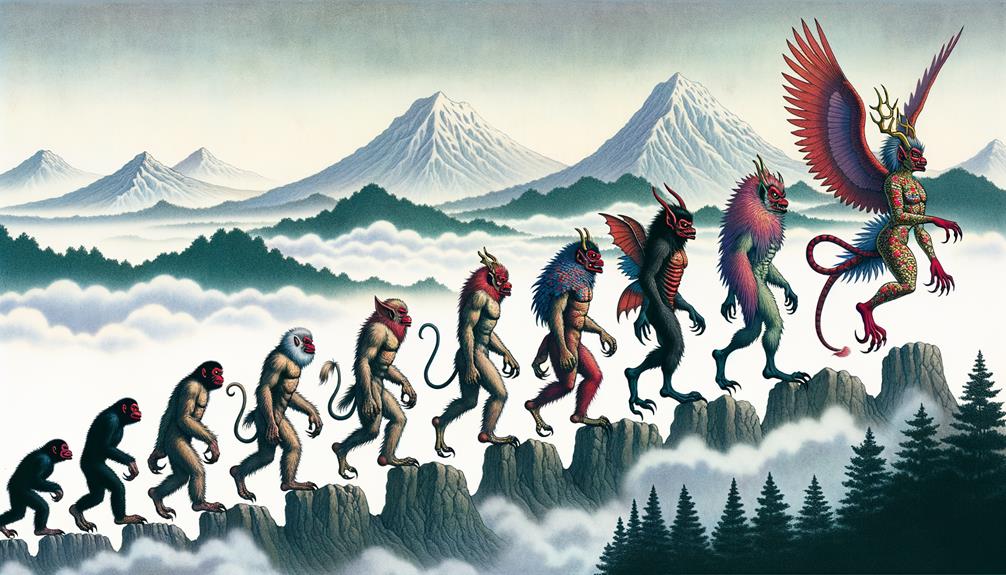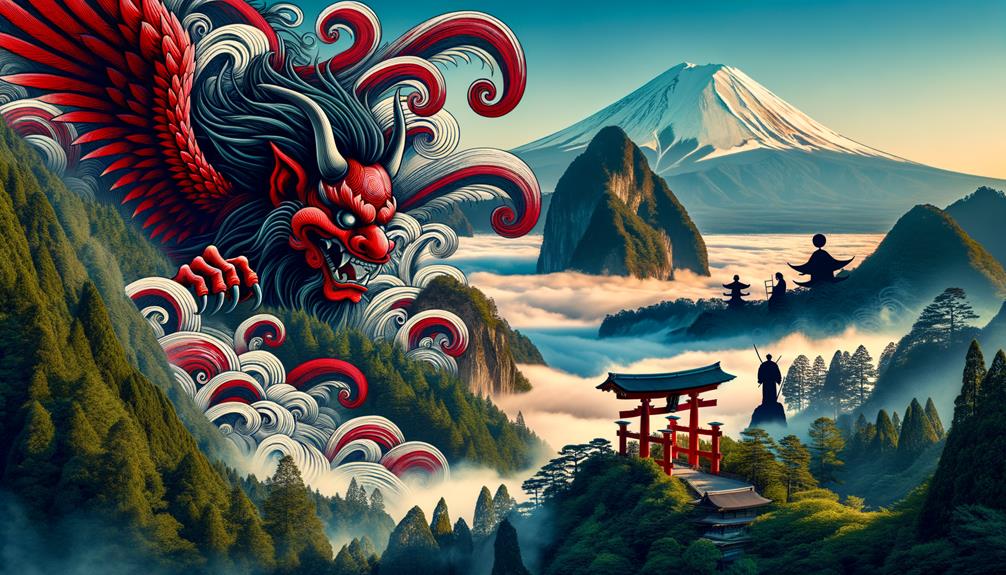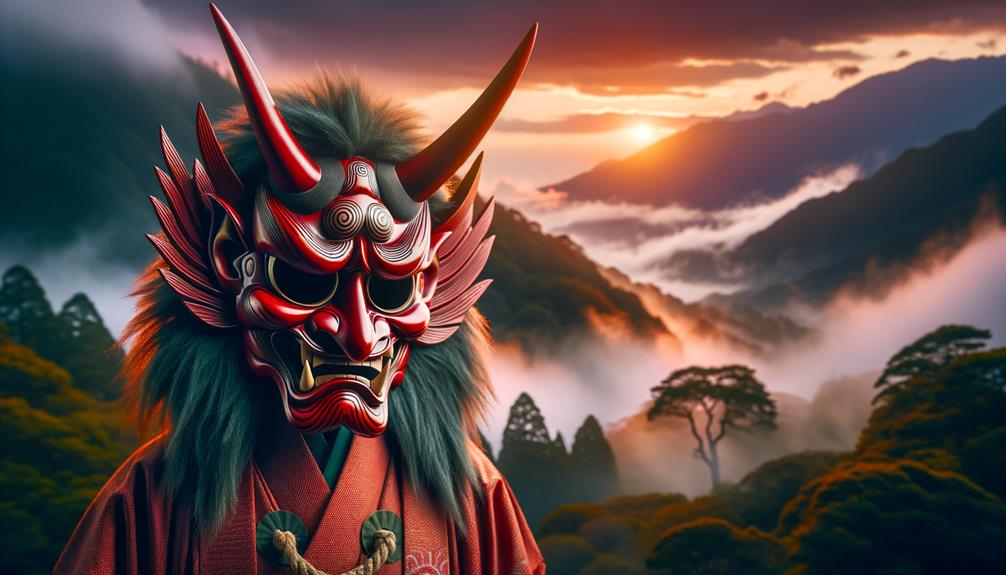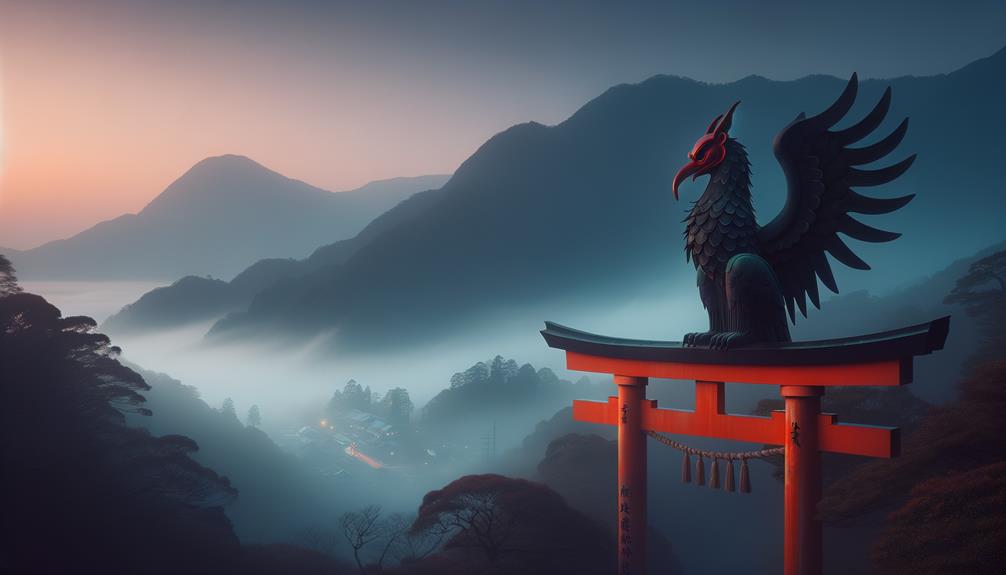Unraveling the Enigma of Tengu: The Japanese Mountain Demon
Diving into the rich and intricate universe of Japanese folklore, we encounter the intriguing figure of Tengu, a creature that embodies a fascinating blend of spiritual aspirations and earthly shortcomings. My journey as a mythology scholar has led me to explore the captivating paradoxes that the Tengu – often portrayed as a bird-like demon nestled in the rugged mountains – presents about the human condition.
Take a closer look beyond their elongated noses and bird-like features, which might seem humorous at first glance. Tengu are far more than meets the eye. Known for their trickery, they also play the role of unlikely benefactors, bestowing martial prowess and spiritual wisdom upon the worthy. Their stories are as varied as the forests they protect – in some, they stand as guardians of nature, while in others, they take a darker turn as relentless kidnappers of innocent children and devout individuals.
The multifaceted nature of the Tengu prompts us to question: What makes this creature such an abundant source of contradiction, and what insights can we glean about the culture that conceived it? Let's uncover the secrets of the Tengu together.
This captivating journey into the world of Tengu offers more than just a deep dive into mythology. It provides a unique opportunity to understand the complexity of human nature through the lens of folklore. It also serves as a reminder of the rich cultural heritage that Japan boasts. Each tale of the Tengu, whether it paints them as protectors or predators, provides a fascinating glimpse into the values, fears, and aspirations of the society that created them.
So, are you ready to embark on this exploration with me? Let's dive deep into the world of Tengu, unraveling the myths and understanding the lessons they teach us. With every story, we'll uncover a new layer of this complex creature and the culture that birthed it. Join me on this journey and let's discover the fascinating world of Japanese mythology together.
Key Takeaway: Tengu, the bird-like mountain demon, is a multifaceted figure in Japanese folklore, reflecting the paradoxical nature of the human experience. As we explore its diverse portrayals, we not only learn about this captivating creature but also gain insights into the rich cultural tapestry of Japan.
Origins of Tengu Mythology

Unraveling the Tengu Mythology: From Celestial Dogs to Birdlike Guardians
Diving into the captivating world of Tengu mythology, we uncover that Tengus originally began their journey as celestial canines, referred to as Tiangou, in the heartlands of China. Making an adventurous journey to Japan around the seventh century, they underwent a remarkable transformation in both their physical representation and cultural symbolism. The Tengu, as we visualize today, is firmly rooted in Japanese folklore, with a fascinating backstory that's anything but linear.
During the culturally rich Heian era, the Tengus were linked with shooting stars, symbolizing harbingers of war, a stark contrast to their peaceful Chinese roots. They were initially portrayed as beings resembling kites, boasting avian features – an homage to their celestial lineage. This archaic Japanese portrayal gradually evolved into the avian characteristics we associate with Tengus today.
But the evolution didn't stop at their physical attributes. In the intricate tapestry of Japanese mythology, Tengus acquired a notorious reputation as antagonists of Buddhism, infamous for leading pious monks away from their spiritual path. Yet, the Edo period heralded a significant change in their characterization. No longer mere birdlike monsters, they ascended to the status of semi-divine entities, thus challenging the preconceived notion of them as fallen creatures. In some interpretations, they even emerged as guardian deities.
Tengu: Enemy or Guardian? Exploring the Shift in Characterization
There's more to the Tengu than meets the eye. As our understanding of these intriguing creatures developed, they transformed from celestial dogs, to kite-like beings, and finally, to birdlike guardians. This evolution not only reflects the dynamism of mythology but also the richness of cultural exchange between China and Japan. Understanding the Tengu's journey helps us appreciate the complexities of mythology and its impact on cultural identities.
Types and Evolution of Tengu

Unraveling the Mystique of Tengu: An Evolutionary Tale
Step into the captivating world of Tengu, and uncover the remarkable transformation of these mythical creatures. Originating as celestial dogs, Tengu evolved into colossal bird-like monsters, or anthropomorphized beings, painting a vibrant picture of Japanese mythology. Among the diverse array of Tengu, the mighty Daitengu and the animal-like Kotengu stand out, each contributing distinct flavors to the rich lore of Japanese folklore.
Tengu's association with martial arts came into prominence during the Edo period. Daitengu, residing on the majestic Mount Kurama, were worshipped as the epitome of warfare expertise. Their extraordinary magical abilities and martial acumen have made them emblematic figures in Japanese culture. On the flip side, the Kotengu were wild cards—unpredictable and often reckless, their nature more akin to untamed animals.
To illustrate the diverse Tengu types, let's consider the following table:
| Type | Description | Example |
|---|---|---|
| Daitengu | Renowned for their martial arts skills and wisdom | Sojobo of Mount Kurama |
| Kotengu | Animalistic in nature, often creating chaos | Karasu Tengu |
The term Tengu, translating to 'heavenly dog', has seen a dynamic representation over the centuries, mirroring the socio-cultural evolution of Japan. For a deeper dive into these enthralling entities, refer to resources like *Izuna Gongen* and the *Encyclopedia of Japanese demons*. The transformation and diversity of Tengu are testament to the intricate and profound nature of Japanese mythology.
Tengu's Influence on Japanese Culture

The Tengu: A Vibrant Thread in Japan's Cultural Fabric
The Tengu's Deep-rooted Influence in Japan
In the colorful panorama of Japan's cultural heritage, the significant role played by the Tengu is impossible to ignore. This mythical creature's influence is deeply ingrained in everything from art and folklore to martial arts, and even permeates Japan's contemporary entertainment industry.
Represented as a Japanese mountain demon, the Tengu's depictions have evolved over time, ranging from monstrous birds to anthropomorphic beings. They have also been portrayed as revered religious figures in works such as the Tenguzōshi Emaki, demonstrating their far-reaching impact on Japanese culture.
The Tengu: Protectors, Teachers, and Icons
The Tengu's cultural imprint extends to Japanese folklore and superstitions. They are often depicted as watchful guardians of select mountains and forests. These mythical beings are portrayed as having the power to both safeguard and bless Buddhist practitioners while also being capable of causing disaster for those who disrespect their territories.
The Tengu's legendary combat abilities have influenced martial arts practices. One notable example is the tale of Minamoto no Yoshitsune, who, according to legend, honed his swordsmanship skills under the tutelage of a Tengu.
From Yōkai to Divinity: The Tengu's Evolution
The Tengu's transformation from a mere yōkai into a divine entity during the Edo period had a profound impact on how they are perceived. Noteworthy scholars like Yanagita Kunio and authors like Shigeru No Nihon Yōkai have delved into these transformations, further highlighting the Tengu's influence on Japanese culture.
The Tengu in Contemporary Japanese Culture
Even today, the Tengu continue to resonate with modern audiences. They are frequently featured in contemporary Japanese fiction, art, and entertainment, underscoring the enduring significance of these Buddhist parables. Whether it's a Tengu appearing in a blockbuster film or a Sasaki ghost materializing in a video game, the Tengu's influence remains pervasive.
Tengu's Role in Literature and Folk Tales

Discover the Multifaceted Tengu in Literature and Folk Tales
Venturing into the realm of literature and folk stories, we unearth the rich and varied depiction of Tengu, underscoring their profound impact on Japanese culture. This Japanese mountain demon, Tengu, emerges as a fascinating celestial figure across numerous tales spun throughout the ages.
The role of Tengu in literature and folk tales is both peculiar and enigmatic. Picture this – a Buddhist monk stumbles upon a group of these intriguing beings. They extend an invitation for him to explore their world the following day, a world teeming with pranks and secrets.
To foster a deeper understanding, let's examine these depictions of Tengu in literature:
- The Tengu as a trickster, derailing the virtuous with their playful antics.
- The notoriety of Tengu as temple robbers, underscoring their resistance to conventional norms.
- Tengu's affiliation with certain mountains, establishing them as forces of natural might.
- The representation of Tengu as martial arts instructors, demonstrating their mastery and insight.
- The metamorphosis of Tengu into kite-like creatures or monstrous birds, emphasizing their mystical essence.
These narratives transform Tengu into a symbol of defiance, wisdom, and the inexplicable.
*"In the world of literature and folk tales, Tengu is a symbol of rebellion, wisdom, and the unexplained."*
Engage with Tengu's Lore
Delving deeper into the lore of Tengu can offer fascinating insights into Japanese culture. Whether it's through reading ancient literature or modern interpretations, the tales of Tengu continue to captivate audiences worldwide. For a comprehensive examination of Tengu's role in literature and folk tales, I recommend "The Tengu Scrolls: Art, Drama, and Fantasy in Japan" by Lea Baten.
Immerse yourself in the world of Tengu and discover why this iconic figure continues to resonate in today's culture. The narratives about Tengu are an exciting way to understand Japanese culture and its rich history. So, go ahead, dive into the captivating world of Tengu and let their tales of wisdom, rebellion, and mystery transport you to a different realm.
Understanding Tengu's Divine Status

Understanding Tengu's Divine Evolution
As we delve into the exceptional transformation of Tengu, a captivating journey unfolds. This journey chronicles Tengu's evolution from fallen creatures to highly esteemed mountain deities and trusted guardians of specific locales in Japanese folklore. It's a tale that is far from ordinary and is integral to fully grasp the divine status of Tengu.
The Tengu Transformation Timeline
| Time Period | The Form of Tengu | Their Status |
|---|---|---|
| Pre-Edo Era | Feathery Monsters | Fallen Creatures |
| Edo Era | Human Figures with Avian Traits and Prominent Noses | Semi-Divine |
| Modern Times | Mountain Hermits Practicing in Secluded Valleys, Gathering Good Fortune and Firefighting | Protectors and Deities |
In the Pre-Edo era, Tengus were initially believed to be bird-like monsters. As we transition into the Edo era, their portrayal morphed into human figures with unique, elongated noses. This modification wasn't just physical but also elevated Tengu from mere supernatural creatures or yōkai to beings of semi-divinity. They were now seen as benefactors to Buddhist institutions rather than instigators of mischief.
In the modern depiction, Tengu are envisioned as mountain hermits, practicing in secluded valleys. They are believed to amass good fortune and take proactive steps to extinguish fires, further solidifying their position as protectors and deities. This astounding transformation of Tengu from a feared creature to a respected deity is a testament to the intriguing metamorphosis of this Japanese mountain demon.
Through this comprehensive exploration, we witness the fascinating evolution of Tengu. It's not just a tale of change but a story that will engage and captivate you. So, let's dive in, explore, and uncover the rich tapestry of Tengu's divine status. It's a journey that promises to be enlightening and engrossing!
Frequently Asked Questions
What Is a Tengu Demon?
Discover the Enigmatic Tengu: A Mythical Creature from Japanese Folklore
The fascinating world of Japanese folklore introduces us to the Tengu, a mythical creature of intriguing characteristics. Often portrayed with a bird-like or human-like appearance and a distinct, elongated nose, the Tengu is a captivating figure that stands out for its unique attributes.
Understanding the Tengu: Mischief, Possession, and Challenges to Buddhism
The Tengu is far from being a simple character in folklore; it's a complex figure associated with mischief and possession. These creatures are notorious for their knack for creating chaos, yet they're not just infamous tricksters. The Tengu are also known for their audacious challenges to Buddhism, making them an important figure in religious narratives.
Still, it's not all about mischief and defiance. The Tengu, surprisingly, are also revered as protectors of specific regions. This dual nature gives them a unique place in folklore, creating a rich tapestry of stories and beliefs around these captivating creatures.
The Tengu: A Unique Blend of Folklore, Religion, and Regionalism
The Tengu provides us a glimpse into the depth and diversity of Japanese folklore. This creature is an excellent example of how folklore, religion, and regionalism can intertwine to create rich, layered narratives. It's a testament to the transformative power of storytelling and the enduring influence of mythology.
Understanding the Tengu goes beyond knowing a creature from a foreign folklore. It's an exploration of cultural narratives, an opportunity to learn about the rich and diverse world of Japanese mythology. So, why not dive deeper into this fascinating world?
A Journey into the World of Tengu: Learning and Exploring
In this journey of discovery, consider immersing yourself in Japanese literature or visiting cultural exhibits that feature Tengu. You could even explore movies, animations, and games that incorporate this unique creature. There's so much to learn and discover about the Tengu and the magnificent world of Japanese folklore.
In conclusion, the Tengu is an intriguing figure that offers a wealth of insights into the richness of Japanese folklore. Its dual nature as a mischief-maker and protector, its challenges to Buddhism, and its role as a regional guardian, all combine to create a fascinating narrative. Engage with the story of the Tengu, and you'll find yourself exploring a world of captivating stories and cultural wonders.
Boldfaced keywords: Tengu, Japanese folklore, mischief, possession, Buddhism, protector, regional guardian.
Are Tengu Good or Evil?
Understanding the Dual Nature of Tengu
Tengu, the enigmatic beings from folklore, don't fit neatly into the categories of good or evil. Their character is as multifaceted as our own human nature, often representing both benevolent and malevolent aspects.
Tengu: The Protectors and Misleaders
Just as the key players in a page-turning novel, Tengu can either deceive or shield, mirroring our inherent potential for both virtuous and harmful actions. These complex creatures, steeped in lore and legend, are a fascinating study of dichotomy.
Tengu's Dual Role: An Example
Consider the symbolic representation of Tengu. They're not just black or white characters. Instead, they embody shades of grey, reflecting the complexities of our human nature. This blend of benevolence and malevolence in their character makes them an intriguing subject in folklore studies.
The Intriguing Tengu
For instance, a Tengu may appear as a protector in one tale, while in another, it might play the role of a trickster. By embodying both roles, they serve as a powerful reflection of our own ability to embody good and evil.
Conclusion: Embrace the Complexity
In conclusion, Tengu's character is not one-dimensional. They are complex beings capable of both benevolent and malevolent actions, much like ourselves. This multifaceted portrayal makes Tengu more than just a folklore creature; they are a fascinating reflection of our own complex natures.
What Are the Powers of the Tengu?
Understanding the Extraordinary Powers of the Tengu
It's fascinating to discover that Tengu, these mystical entities, are endowed with an array of impressive abilities. They possess the power of flight, the intriguing skill of shape-shifting, and the mind-bending ability to communicate through telepathy.
Mastery of Martial Arts and Control Over Natural Disasters
Tengu are not just magically proficient; they're also evidently well-versed in martial arts, showcasing an extraordinary level of physical prowess. Interestingly, they're also equipped with the formidable power to stir up natural calamities.
The Tengu's Unsettling Talent for Abduction
A rather disturbing aspect of the Tengu's abilities is their uncanny knack for abducting people. It's a peculiar skill that adds a layer of mystery and intrigue to these beings.
In a nutshell, the Tengu are a captivating blend of magical abilities and physical skills. Their powers not only underscore their superiority in the mystical realm but also make them an intriguing subject of study. Their unique combination of abilities paints a compelling picture of these enigmatic entities, making them a riveting topic of exploration for those interested in mythology and folklore.
Remember, the world is full of mysteries waiting to be unraveled, and the powers of the Tengu are just one captivating example. Be it their telepathic communication abilities, their martial arts expertise, or their control over natural disasters, each facet of the Tengu's powers invites us to delve deeper and learn more about these fascinating entities.
Unlock the Enigma of the Tengu
What Are the Two Types of Tengu?
Dive Into the World of Tengu: The Daitengu and Kotengu
In the mysterious realm of Japanese folklore, two unique types of Tengu stand out: Daitengu and Kotengu or Karasutengu. Let's delve into their intriguing characteristics.
Daitengu: The Enlightened Powerhouses
Daitengu, these extraordinary entities, are not merely semi-human but they're also blessed with profound wisdom and immense power. Their remarkable intelligence not only sets them apart, but also makes them a formidable force. Imagine the brilliant mind of Einstein combined with the might of a demigod; that's Daitengu for you!
Kotengu or Karasutengu: The Lesser Beings
On the other hand, we have the Kotengu or Karasutengu, who are comparatively less intimidating. They're more akin to animals in nature, lacking the intellectual prowess of their Daitengu counterparts. Think of them as the mischievous monkeys of the Tengu world, with their wily antics and lesser capabilities.
Daitengu vs. Kotengu: A Comparative Analysis
In the grand scheme of things, the intelligence of Daitengu significantly overshadows that of Kotengu, making them the more formidable of the two. It's like comparing a seasoned chess grandmaster with a novice player; the difference is clear and significant. However, each has their unique place in the rich tapestry of Japanese folklore.
In this fascinating world of Tengu, where wisdom and power dance an eternal tango, one can't help but be pulled in. Dive deeper, explore more, and let the intriguing tales of Daitengu and Kotengu captivate your imagination!

